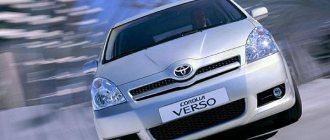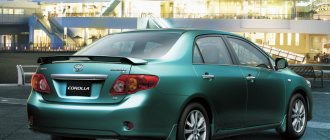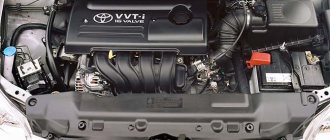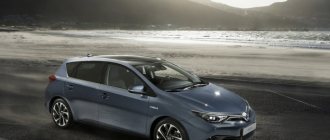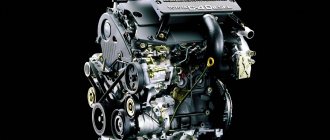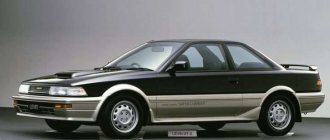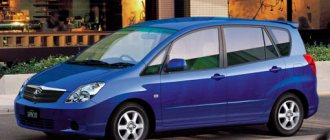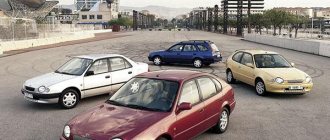A little history of the model
Although the car's design is based on the Corolla, the Verso is built on its own unique platform. Compared to its namesake, only the wheelbase remained unchanged in the Verso, and all dimensions were noticeably increased. The car has a very dynamic appearance and offers a spacious interior with a Flat-7 transformation system, which provides numerous layout versions, which already makes Verso an ideal family car.
Toyota Corolla Spacio first generation (Japan)
Third generation 2007-2008
In 2007, as a result of improvements, the third generation was released, which retained the overall dimensions of the previous versions.
The development of this generation was carried out by the European Toyota studio, which suggests that it was targeted specifically at the European market. As a result of these changes, the body became visually divided into two parts. A roof that creates the illusion of movement even when the car is not moving, and extended arches with a bumper. The model continued to be developed with family needs in mind. If necessary, the rear passenger seats could be completely folded.
All interior parts were made from high-quality materials, unusual for this class of car.
The engines were installed as gasoline with a volume of 1.6 and 1.8 liters and diesel 2.2 liters, the transmission in both cases could be installed as a classic mechanics or a robotic gearbox.
As for safety systems, the Toyota Corolla Verso is equipped with nine airbags and an audible seat belt warning system.
Models released in 2008 were technically equipped in the same way as models released earlier, the only thing that was added was the ability to install a start system and keyless entry.
First generation (JDM, E110; 1997-2001)
The first generation Corolla Verso, intended for the domestic market, was presented as a minivan with two gearboxes, which was technically similar to the Avensis of the time. The new body panels were stamped by longtime Toyota supplier Kanto Autoworks.
Power unit 4A-FE in the engine compartment of Toyota Corolla Spacio
The 1st generation model (E110) was produced with the following engines (4-cylinder, 16-valve, DOHC) with volumes of 1.6 and 1.8 liters, respectively:
- 4A-FE (torque – 149 N*m at 4600 rpm);
| 4A-FE | |
| Volume, cm3 | 1587 |
| Power, hp | 99-116 |
| Consumption, l/100 km | 3.9-10.9 |
| Ø cylinder, mm | 81 |
| CC | 09.05.2011 |
| HP, mm | 77-78 |
| Models | Avensis; Carina; Carina E; Celica; Corolla; Corolla Ceres; Corolla FX; Corolla Levin; Corolla Spacio; Corona; Corona Premium; Sprinter; Sprinter Carib; Sprinter Marino; Sprinter Trueno |
| Resource in practice, thousand km | 300+ |
- 7A-FE (torque - 159 N*m at 2800 rpm).
| 7A-FE | |
| Volume, cm3 | 1762 |
| Power, hp | 103-120 |
| Consumption, l/100 km | 03.06.2010 |
| Ø cylinder, mm | 81 |
| CC | 09.05.2010 |
| HP, mm | 81.5-86 |
| Models | Avensis; Caldina; Carina; Carina E; Celica; Corolla; Corolla Spacio; Corona Premium; Sprinter Carib |
| Resource, thousand km | 300+ |
The manual transmission was equipped with a 1.6-liter internal combustion engine, and cars with a 1.8-liter engine were equipped with an automatic transmission.
First generation
The appearance of this model was a real gift for those who wanted to buy a minivan, but could not afford it, since the price of such a car was high, and its large dimensions did not allow it to be used comfortably in urban conditions. But Toyota designers were able to solve this problem and as a result, the Spacio model was born, which had five doors and three rows of seats.
It was a completely family car with all the necessary technical equipment, for example: automatic transmission, anti-lock brakes.
The middle row was usually used for transporting children, and it could be completely removed or transformed into a table. The passenger seat located in front was completely turned in the opposite direction , this was done for the convenience of mothers. The entire interior could be converted into a sleeping area that could comfortably accommodate two adults.
For the woman’s convenience, all dial instruments on the panel were replaced with a display, and the interior was also equipped with such small things as additional cup holders, sockets and additional lighting. The car was equipped with a 1.6 and 1.8 liter engine with 110/125 horsepower.
Second generation (E120; 2001-2007)
The second generation Corolla Spacio was released in Japan in May 2001. The car entered the European market as the Corolla Verso later that year and after being shown at the Frankfurt Motor Show in September. An updated version of Spacio appeared on the Japanese car market in April 2003.
Engine 1NZ-FE in the engine compartment of Toyota Corolla E120
In 2002, Verso showed good sales dynamics, so already in 2004 the next generation of the car was released, which was even more aimed at European consumers. They produced cars with the following gasoline (1.5 and 1.8 liter) engines (16 valves, with two overhead camshafts):
- 1NZ-FE (torque - 147 N*m at 5200 rpm);
| 1NZ-FE | |
| Volume, cm3 | 1496 |
| Power, hp | 103-119 |
| Consumption, l/100 km | 4.9-8.8 |
| Ø cylinder, mm | 72.5-75 |
| CC | 10.5-13.5 |
| HP, mm | 84.7-90.6 |
| Models | Allex; Allion; Auris; Bb; Corolla; Corolla Axio; Corolla Fielder; Corolla Rumion; Corolla Runx; Corolla Spacio; Echo; funcargo; ist; Platz; Porte; Premium; Probox; Ractis; Raum; Sienta; Spade; Succeed; Vitz; WiLL Cypha; WiLL VS; Yaris |
| Resource, thousand km | 200+ |
- 1ZZ-FE (torque – 192 N*m at 4000 rpm).
| 1ZZ-FE | |
| Volume, cm3 | 1794 |
| Power, hp | 120-145 |
| Consumption, l/100 km | 4.2-9.9 |
| Ø cylinder, mm | 79-86 |
| CC | 09.08.2010 |
| HP, mm | 86-92 |
| Models | Allex; Allion; Avensis; Caldina; Celica; Corolla; Corolla Fielder; Corolla Runx; Corolla Spacio; Corolla Verso; Isis; Matrix; MR-S; Opa; Premi; RAV4; Vista; Vista Ardeo; Voltz; WiLL VS; Wish |
| Resource, thousand km | 200+ |
In the second generation, consumers were given a choice of five-speed manual transmission or robotic gearbox. This version of the Corolla Verso was produced until 2006, until the 2nd generation of the car was restyled, as a result of which the Toyota Corolla Verso - AR10 appeared in 2007.
Second generation 2005
The new modification in 2005 was completely changed to suit the preferences of the European consumer. The body became completely different, and the engines were also changed.
For the Russian market there were two configurations to choose from:
- Tera, was a standard package and was equipped with a manual transmission;
- Sol, the equipment compared to the first one had richer technical equipment and a robotic gearbox.
The second generation was equipped with 1.6 and 1.8 liter engines whose power was 129/136 hp. The first option was equipped only with a manual transmission , but the 1.8 liter engine could also be equipped with an automatic transmission. In addition, it was possible to choose a version with a diesel engine whose power was 90 hp.
The second generation minivan was produced until 2006, after which it was restyled in 2007.
Third generation (second generation restyling) (AR10; 2004-2009)
The third generation Corolla Verso was unveiled at the 2004 Geneva Motor Show and turned out to be one of the first Toyota vehicles designed outside of Japan. The restyled Corolla Verso was developed at Toyota's European design center in the south of France and assembled in northwestern Turkey, in Adapazari.
Motor 1AD-FTV under the hood of Toyota Corolla Verso 2.0
This generation was primarily aimed at the European market, where it became one of the best-selling compact MPVs in the class.
The third generation Corolla Verso was offered with four powertrain options:
- 1ZZ-FE (gasoline 8 liters, 16 valves, DOHC, with chain drive; with a torque of 192 N*m at 4000 rpm);
- 3ZZ-FE (gasoline 1.6 l; 16-valve DOHC VVT-i, with chain drive; with a maximum torque of 162 N*m at 4800 rpm);
| 3ZZ-FE | |
| Volume, cm3 | 1598 |
| Power, hp | 108-110 |
| Consumption, l/100 km | 6.9-9.7 |
| Ø cylinder, mm | 79 |
| CC | 10.05.2011 |
| HP, mm | 81.5-82 |
| Models | Avensis; Corolla; Corolla Verso |
| Resource, thousand km | 200+ |
- 1AD-FTV (turbo diesel 2.0 l, in-line, 4-cylinder, with common-rail direct fuel injection; with a maximum torque of 310 N*m at 3600 rpm);
| 1AD-FTV turbo | |
| Volume, cm3 | 1998 |
| Power, hp | 124-127 |
| Consumption, l/100 km | 4.9-5.7 |
| Ø cylinder, mm | 86 |
| CC | 15.8-16.8 |
| HP, mm | 86 |
| Models | Auris; Avensis; Corolla; Corolla Verso; Toyota RAV4 |
| Resource, thousand km | 300 |
- 2AD-FTV (turbo diesel 2.2 l, in-line, 4-cylinder DOHC; with a maximum torque of 400 N*m at 3600 rpm).
| 2AD-FTV turbo diesel | |
| Volume, cm3 | 2231 |
| Power, hp | 136-177 |
| Consumption, l/100 km | 5.9-7.2 |
| Ø cylinder, mm | 86 |
| CC | 15.08.2019 |
| HP, mm | 66-96 |
| Models | Auris; Avensis; Corolla Verso; RAV4 |
| Resource, thousand km | 300 |
The European specification Corolla Verso was available not only in Europe, but also in Morocco, Kenya and even South Africa. The car was not sold at all in Japan.
In 2009, based on the 2007 Corolla Verso, a “new” compact minivan model called the first generation Toyota Verso R20 was developed.
Characteristics of Toyota Corolla Verso / Toyota Corolla Verso
The first generation of Toyota Corolla Verso compact vans debuted in 2001, three years later it was replaced by a larger second-generation model.
The styling of the 2004 models was designed in the Toyota ED2 design studio, taking into account the tastes of European buyers. The body of the Corolla Verso can be visually divided into two parts. The lower one includes bumpers, wheel arches and panels. The top one has a curved roof and rear side windows, giving the car a dynamic look. Toyota's brand identity is emphasized by the familiar triangular glass shape of the rear quarter panels and the inverted "L" taillights. The careful design of Corolla Verso results in a class-leading drag coefficient of 0.30.
Corolla Verso and Toyota Corolla have only the name in common. There is no platform relationship, like the first generation of five-seat Verso. The market demanded a seven-seat modification, and in order not to overload the chassis, it was decided to use components and assemblies of the larger Avensis. As a result, the width of the compact van has increased by 65 mm, the wheelbase has increased by 150 mm, and the maximum weight has increased by 300 kg. The result was a completely new independent model, but the name Toyota Corolla Verso was retained.
The main advantage of the Corolla Verso is its comfortable, spacious interior that can accommodate seven adults. Thanks to the Easy Flat 7 system with seven separate adjustable seats, the car has the widest possibilities for transforming the interior. All five seats in the second and third rows can be folded down to create a spacious, completely flat area. The Easy Flat-7 system offers thirty seating options.
Luggage compartment volume can vary from 91 to 779 liters. By folding all the seats, we get an impressive space: 1980 mm in length and 1370 mm in width.
For the convenience of drivers, the height of the front seats, reach and tilt of the steering wheel are adjustable. The creators of Corolla Verso paid special attention to the ergonomics of the driver's workplace - instruments and controls are located intuitively, simply and conveniently.
As befits a car of this level, the Corolla Verso is equipped with a whole range of safety systems designed to improve the car's handling and help avoid unpleasant situations. In EuroNCAP crash tests, the Corolla Verso received five stars and scored 35 points, showing the highest result in its class. The MICS (Minimal Intrusion Cabin System) interior protection system developed by Toyota is integrated into the design of this car. The car has several elements that have become new in this class of cars, for example, a full set of nine airbags (including airbags for protecting the knees) and a two-stage light and sound warning system for unfastened seat belts.
From Avensis, the compact van also received improved brakes - four disc mechanisms ensure safety with the help of an anti-lock braking system (ABS) and an electronic brake force distribution (EBD). And the more expensive version of the Corolla Verso also has brake assist (BA), vehicle stability control (VSC) and traction control (TRC).
Range of engines: petrol 1.6 l (110 hp); 1.8 l (129 hp) and turbodiesels for Europe with a volume of 2.0 l (116 hp) with a CR system and particulate filter and 2.0 l (90 hp). The choice of gearbox is 5-speed manual, 4- or 5-speed automatic. For the Japanese market, the Corolla Spacio is offered with 1.5 liter (109 hp) or 1.8 liter engines and only with a 4-speed automatic transmission.
On the Russian market, the Toyota Corolla Verso is offered only in a seven-seater version and only with a 1.8 liter gasoline engine, but in two trim levels: “Terra” and “Sol”. The Terra version is equipped with electric drive and heated side mirrors, ABS, radio with CD, nine airbags, air conditioning and front electric windows. This version is equipped with a conventional Terra manual transmission, as well as a robotic manual transmission (M-MT). The Sol version is offered only with a robotic gearbox and is additionally equipped with ESP, climate control, a full set of electric windows and cruise control.
The Corolla Verso is the true embodiment of intelligence, innovation and versatility. The car is ideal for today's active lifestyle.
The Corolla Verso is produced at the TMMT plant in Adapazari (Turkey), and the version for Japan (Corolla Spacio) is assembled at the Higashi-Fuji plant.
First generation Corolla Verso in the E110 body
The first generation minivan, produced at the Toyota plant in Turkey and intended for European car enthusiasts, had a passenger platform from the most popular Corolla model of the Japanese automaker, but at the same time different weight and dimensions. The manufacturer has significantly increased the body in all respects: length by 180 mm, width by 75 mm and height by 155 mm.
A distinctive feature that helped this model stand out from competing minivans from other automakers was the new seat transformation system, called Flat-7, which has various adjustment options in thirty positions. The first generation was produced until the end of 2004, when the manufacturer updated the model, which received a new body labeled E120.
Advantages and disadvantages
Like all cars, the Toyota Verso has advantages and disadvantages. The advantages of the car include:
- Spacious and compact. For a minivan, the Toyota Corolla Verso has small dimensions, but the car can fully accommodate 7 people.
- Reliability. It's a Toyota)
- Safety. The car is equipped with 7 airbags, and there are ISOFIX mounts for child car seats. The advantage of the 2007 Verso is that it has 5 stars in the Euro NCAP safety test.
- Low cost of consumables.
- Easily transformable interior, if necessary increases the volume of the trunk.
- Relatively low gasoline consumption.
The main disadvantage of the Toyota Verso is the gearbox. The manual transmission lacks a 6th stage, and the robotic transmission requires serious modifications, since the gear shift speed is five times lower than that of a manual transmission.
Video
The Toyota company has released for European countries a rather specific car in the back of the Toyota Corolla Verso minivan with high-level technical characteristics, excellent maneuverability and a passenger platform. All this allowed the car to become one of the most popular in this market segment among many car enthusiasts. The growth in sales, which allowed Toyota to further modernize the new product, was facilitated by the various configurations of the model and its pleasant appearance, which is clearly visible in the photos presented on the Internet.
Technical parameters of the third generation Verso
The 2007 Toyota Corolla Verso fully retained the weight and dimensions of the second generation car, which looked like this:
- 4360 mm total body length;
- 1770 mm – full width;
- 1620 mm minivan body height parameter;
- 2750 mm – distance between axles (wheelbase);
- 1505 mm and 1495 mm – the size of the front and rear tracks, respectively;
- The equipped car weighs 1400 kg.
The line of power units in the 2007 Toyota Corolla Verso for the Russian market has not undergone any changes; it still consists of one 1.8-liter engine, the power of which is 129 horses with a maximum torque of 170 Nm, achieved at 4200 rpm. It is paired with the same two transmission options, one mechanical, the other robotic with five steps each.
Unlike the Russian modification, this model was supplied to the European market with an expanded line of power units, which included the following engines:
- petrol in-line four with a volume of 1.6 liters and a VVT-i gas distribution system, power is 110 horses;
- 2-liter in-line diesel four with a capacity of 116 horses;
- 2.2-liter diesel four with 136 horsepower;
- A 2.2-liter diesel four with a D-Cat injection system, allowing the engine to develop power up to 177 horses.
The designations and technical equipment of the trim levels have been preserved in the updated minivan, where the base option is Terra, and Sol is considered the maximum, which could be slightly expanded by installing a new multimedia system that supports navigator mode and has the ability to synchronize via Bluetooth with the driver’s smartphone.
This technical equipment was fully preserved in the modification of the 2008 Toyota Corolla Verso, in which a distinctive feature was the ability to install a keyless entry and car start system as an additional option.
